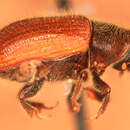Conservation Status
provided by University of Alberta Museums
This species is considered a pest throughout most of its range.
- license
- cc-by-nc
- copyright
- University of Alberta Museums
Cyclicity
provided by University of Alberta Museums
Flight period is from late June through to early September.
- license
- cc-by-nc
- copyright
- University of Alberta Museums
Distribution
provided by University of Alberta Museums
These beetles are found in pine forests in Canada from British Columbia to Ontario. They have also been found in the USA in Idaho, Minnesota, Michigan, Colorado, Utah and Wyoming.
- license
- cc-by-nc
- copyright
- University of Alberta Museums
General Description
provided by University of Alberta Museums
The frons has fine punctures with sparse granules. The pronotum has coarse punctures. Has a narrow epistomal process. The declivity is steep and convex. The striae on the declivity are weak impressions and have minute punctures on the declivity. This species has distinct male genitalia. Size ranges from 5.0 mm to 7.3 mm. Pronotum is dark brown and elytra are reddish brown. The distinct punctures on the frons and pronotum allow it to be distinguished from D. punctatus. The distinct frons, male genitalia and galleries distinguish it from D. rufipennis.
- license
- cc-by-nc
- copyright
- University of Alberta Museums
Habitat
provided by University of Alberta Museums
Stumps, windfall and overmature or weakened trees with a DBH of 20 cm or more.
- license
- cc-by-nc
- copyright
- University of Alberta Museums
Life Cycle
provided by University of Alberta Museums
In the spring, overwintering larvae and both young and adults will become active as the local weather begins to warm. Females will emerge and begin to build new galleries in the phloem region of the tree. The galleries are vertical and are shaped irregularly. The galleries have a main region and two or three shallow expansions along the sides of the gallery are excavated. No egg niches are excavated. They will be joined by the male and mating will occur. Eggs are laid in groups of 20 to 50 and after about 10 days they hatch. Females may re-emerge from the gallery and find a new host tree to start a new gallery if sufficient time remains in the season. Larvae feed in groups and will feed in irregular patterns characteristic of the species, leaving some parts of the phloem uneaten. It takes approximately one year for larvae to develop.
- license
- cc-by-nc
- copyright
- University of Alberta Museums
Trophic Strategy
provided by University of Alberta Museums
This species mainly feeds on Pinus banksiana (Jack Pine), P. contorta (Lodgepole Pine) in Alberta. It also feeds on P. strobus outside of Alberta.
- license
- cc-by-nc
- copyright
- University of Alberta Museums
Dendroctonus murrayanae
provided by wikipedia EN
- license
- cc-by-sa-3.0
- copyright
- Wikipedia authors and editors
Dendroctonus murrayanae: Brief Summary
provided by wikipedia EN
Dendroctonus murrayanae, the lodgepole pine beetle, is a species of crenulate bark beetle in the family Curculionidae. It is found in North America.
- license
- cc-by-sa-3.0
- copyright
- Wikipedia authors and editors

